Pandas Cookbook
2020-07-29
- 使用 RMarkdown 的
child参数,进行文档拼接。 - 这样拼接以后的笔记方便复习。
- 相关问题提交到 Issue
1 floor 到每周处理方法
参考 Reback (2017) 和 Leung (2018)
time_column = pd.to_datetime(df2['time'])
time_column = time_column.dt.to_period("W").dt.to_timestamp()如果使用 pd.Series.dt.floor("M") 会产生报错ValueError: <MonthEnd> is a non-fixed frequency。
例如,
numpy.matrix| 0 | 1 | 2 | 3 | 4 | 5 | 6 | 7 | 8 | 9 | 10 | 11 | 12 | 13 | 14 | |
|---|---|---|---|---|---|---|---|---|---|---|---|---|---|---|---|
| 0 | 0.115958 | 0.000000 | 0.0 | 0.0 | 0.000000 | 0.059606 | 0.011118 | 0.382871 | 0.022741 | 0.000000 | 0.000000 | 0.036845 | 0.059429 | 0.0 | 0.311433 |
| 1 | 0.707055 | 0.000000 | 0.0 | 0.0 | 0.016321 | 0.000000 | 0.000000 | 0.000000 | 0.000000 | 0.000000 | 0.000000 | 0.000000 | 0.072367 | 0.0 | 0.204257 |
| 2 | 0.000000 | 0.000000 | 0.0 | 0.0 | 0.139806 | 0.000000 | 0.000000 | 0.128367 | 0.000000 | 0.000000 | 0.288471 | 0.418322 | 0.000000 | 0.0 | 0.025034 |
| 3 | 0.012516 | 0.000000 | 0.0 | 0.0 | 0.136892 | 0.000000 | 0.000000 | 0.284297 | 0.000000 | 0.036387 | 0.000000 | 0.135912 | 0.000000 | 0.0 | 0.393996 |
| 4 | 0.000000 | 0.013008 | 0.0 | 0.0 | 0.000000 | 0.000000 | 0.000000 | 0.024693 | 0.000000 | 0.039126 | 0.000000 | 0.906986 | 0.000000 | 0.0 | 0.016187 |
(133201, 15)
#import time series
df2 = pd.read_csv('../data/df_japan.csv',header=None,encoding='gbk',names=['time','none','catagory','title','content'])| time | none | catagory | title | content | |
|---|---|---|---|---|---|
| 0 | 1946.05.15 | 3.0 | NaN | 苏评论家马西努著论痛斥阎锡山勾结日寇美军帮助日阎进攻解放区,不符莫斯科三国决议 | 痛斥阎锡山勾结日寇美军帮助日阎进攻解放区,不符莫斯科三国决议【新华社延安十二日电】莫斯科广播… |
| 1 | 1946.05.15 | 3.0 | NaN | 片山组阁搁浅日共力主联合内阁 | 日共力主联合内阁【新华社延安十二日电】东京讯:日本社会党领导人,日来与日共谈判组织新阁问题,… |
| 2 | 1946.05.15 | 4.0 | NaN | 五月杂感 | 张香山一到日历翻掀到五月,总感到有些沉重,那种触目惊心的流血,暴虐耻辱的日子,实在太多了——… |
| 3 | 1946.05.16 | 1.0 | NaN | 苏皖冀晋鲁豫各地战云密布国民党策动全面内战倾两师之众进迫我定远县境兖州伪逆吴化文部二千余出犯被击退 | 国民党策动全面内战倾两师之众进迫我定远县境兖州伪逆吴化文部二千余出犯被击退【新华社延安十三日… |
| 4 | 1946.05.16 | 2.0 | NaN | 今日的“丛台”记边区卫生局流诊所 | 记边区卫生局流诊所邯郸城厢东北角的“丛台”,据说是战国时代赵武灵王的遗址。为了这几个小土阜和… |
time_column = pd.to_datetime(df2['time'])
time_column = time_column.dt.to_period("W").dt.to_timestamp()(133201,)
| time | 0 | 1 | 2 | 3 | 4 | 5 | 6 | 7 | 8 | 9 | 10 | 11 | 12 | 13 | 14 | |
|---|---|---|---|---|---|---|---|---|---|---|---|---|---|---|---|---|
| 0 | 1946-05-13 | 0.115958 | 0.000000 | 0.0 | 0.0 | 0.000000 | 0.059606 | 0.011118 | 0.382871 | 0.022741 | 0.000000 | 0.000000 | 0.036845 | 0.059429 | 0.0 | 0.311433 |
| 1 | 1946-05-13 | 0.707055 | 0.000000 | 0.0 | 0.0 | 0.016321 | 0.000000 | 0.000000 | 0.000000 | 0.000000 | 0.000000 | 0.000000 | 0.000000 | 0.072367 | 0.0 | 0.204257 |
| 2 | 1946-05-13 | 0.000000 | 0.000000 | 0.0 | 0.0 | 0.139806 | 0.000000 | 0.000000 | 0.128367 | 0.000000 | 0.000000 | 0.288471 | 0.418322 | 0.000000 | 0.0 | 0.025034 |
| 3 | 1946-05-13 | 0.012516 | 0.000000 | 0.0 | 0.0 | 0.136892 | 0.000000 | 0.000000 | 0.284297 | 0.000000 | 0.036387 | 0.000000 | 0.135912 | 0.000000 | 0.0 | 0.393996 |
| 4 | 1946-05-13 | 0.000000 | 0.013008 | 0.0 | 0.0 | 0.000000 | 0.000000 | 0.000000 | 0.024693 | 0.000000 | 0.039126 | 0.000000 | 0.906986 | 0.000000 | 0.0 | 0.016187 |
(3823, 15)
2 groupby
参考 易执 (2020)
#export
def build_data():
np.random.seed(100)
company=["A","B","C"]
data=pd.DataFrame({
"company":[company[x] for x in np.random.randint(0,len(company),10)],
"salary":np.random.randint(5,50,10),
"age":np.random.randint(15,50,10)
}
)| company | salary | age | |
|---|---|---|---|
| 0 | A | 19 | 17 |
| 1 | A | 39 | 42 |
| 2 | A | 29 | 19 |
| 3 | C | 20 | 46 |
| 4 | C | 41 | 16 |
| 5 | A | 48 | 28 |
| 6 | C | 21 | 34 |
| 7 | B | 14 | 19 |
| 8 | C | 34 | 42 |
| 9 | C | 27 | 18 |
pandas.core.groupby.generic.DataFrameGroupBy
[(‘A’, company salary age 0 A 19 17 1 A 39 42 2 A 29 19 5 A 48 28), (‘B’, company salary age 7 B 14 19), (‘C’, company salary age 3 C 20 46 4 C 41 16 6 C 21 34 8 C 34 42 9 C 27 18)]
| salary | age | |
|---|---|---|
| company | ||
| A | 33.75 | 26.5 |
| B | 14.00 | 19.0 |
| C | 28.60 | 31.2 |
| salary | age | |
|---|---|---|
| company | ||
| A | 33.75 | 23.5 |
| B | 14.00 | 19.0 |
| C | 28.60 | 34.0 |
| salary | age | |
|---|---|---|
| company | ||
| A | 33.75 | 23.5 |
| B | 14.00 | 19.0 |
| C | 28.60 | 34.0 |
这里 agg 相当于 dplyr::summarize,而transform 相当于 dplyr::mutate
| salary | age | |
|---|---|---|
| 0 | 33.75 | 26.5 |
| 1 | 33.75 | 26.5 |
| 2 | 33.75 | 26.5 |
| 3 | 28.60 | 31.2 |
| 4 | 28.60 | 31.2 |
| 5 | 33.75 | 26.5 |
| 6 | 28.60 | 31.2 |
| 7 | 14.00 | 19.0 |
| 8 | 28.60 | 31.2 |
| 9 | 28.60 | 31.2 |
3 pandas 1.0.0
参考 https://dev.pandas.io/docs/whatsnew/v1.1.0.html
‘1.0.0rc0’
<class ‘pandas.core.frame.DataFrame’>
RangeIndex: 3 entries, 0 to 2
Data columns (total 3 columns):
# Column Non-Null Count Dtype
— —— ————– —–
0 A 3 non-null int64
1 B 3 non-null object
2 C 3 non-null bool
dtypes: bool(1), int64(1), object(1)
memory usage: 179.0+ bytes
(‘| | A | B | C |’ ‘|—:|—-:|:—-|:——|’ ‘| 0 | 1 | a | False |’ ‘| 1 | 2 | b | True |’ ‘| 2 | 3 | c | False |’)
参考 Datawhale (2020)
1.0.0rc0 1.17.4
4 import pandas series
0 0 1 1 2 2 3 3 4 4 dtype: int64
a [1, 2] b [2, 3] c [3, 4] d [4, 5] e [5, 6] dtype: object
1
5 cut number
df = pd.DataFrame({'A': [1,2,11,11,33,34,35,40,79,99],
'B': [1,2,11,11,33,34,35,40,79,99]})
print(df)
df1 = df.groupby(pd.cut(df['A'], np.arange(0, 101, 10)))['B'].sum()
print(df1)A B 0 1 1 1 2 2 2 11 11 3 11 11 4 33 33 5 34 34 6 35 35 7 40 40 8 79 79 9 99 99 A (0, 10] 3 (10, 20] 22 (20, 30] 0 (30, 40] 142 (40, 50] 0 (50, 60] 0 (60, 70] 0 (70, 80] 79 (80, 90] 0 (90, 100] 99 Name: B, dtype: int64
6 plot
df = pd.DataFrame({"revenue":[57,68,63,71,72,90,80,62,59,51,47,52],
"advertising":[2.1,1.9,2.7,3.0,3.6,3.2,2.7,2.4,1.8,1.6,1.3,1.9],
"month":range(1,13)})
ax = df.plot.bar("month", "revenue", color = "green")
df.plot.line("month", "advertising", secondary_y = True, ax = ax)
ax.set_xlim((-1,12));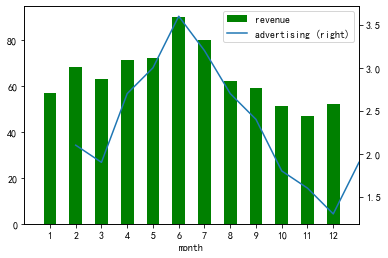
png
7 groupby 看统计结果
参考 Friedman (2020) describe().unstack()
# Import stats module
from scipy import stats
# Compute average age just below and above the threshold
era_900_1100 = df.loc[(df['expected_recovery_amount']<1100) &
(df['expected_recovery_amount']>=900)]
by_recovery_strategy = era_900_1100.groupby(['recovery_strategy'])| id | expected_recovery_amount | actual_recovery_amount | recovery_strategy | age | sex | |
|---|---|---|---|---|---|---|
| 158 | 520 | 900 | 504.790 | Level 0 Recovery | 34 | Male |
| 159 | 1036 | 900 | 539.535 | Level 0 Recovery | 34 | Female |
| 160 | 1383 | 900 | 554.745 | Level 0 Recovery | 24 | Male |
| 161 | 998 | 901 | 887.005 | Level 0 Recovery | 32 | Male |
| 162 | 1351 | 903 | 667.035 | Level 0 Recovery | 28 | Male |
recovery_strategy
count Level 0 Recovery 89.000000
Level 1 Recovery 94.000000
mean Level 0 Recovery 27.224719
Level 1 Recovery 28.755319
std Level 0 Recovery 6.399135
Level 1 Recovery 5.859807
min Level 0 Recovery 18.000000
Level 1 Recovery 18.000000
25% Level 0 Recovery 23.000000
Level 1 Recovery 24.000000
50% Level 0 Recovery 26.000000
Level 1 Recovery 29.000000
75% Level 0 Recovery 31.000000
Level 1 Recovery 33.000000
max Level 0 Recovery 56.000000
Level 1 Recovery 43.000000
dtype: float648 插入新行
参考 https://mp.weixin.qq.com/s/DS36kseh4hLW7i6hG_wwAA
## a b
## 0 1 3
## 1 2 4## a b
## 0 1 3
## 1 5 69 loc 用数字 index
参考 https://mp.weixin.qq.com/s/DS36kseh4hLW7i6hG_wwAA
import pandas as pd
import numpy as np
data = {'animal': ['cat', 'cat', 'snake', 'dog', 'dog', 'cat', 'snake', 'cat', 'dog', 'dog'],
'age': [2.5, 3, 0.5, np.nan, 5, 2, 4.5, np.nan, 7, 3],
'visits': [1, 3, 2, 3, 2, 3, 1, 1, 2, 1],
'priority': ['yes', 'yes', 'no', 'yes', 'no', 'no', 'no', 'yes', 'no', 'no']}
labels = ['a', 'b', 'c', 'd', 'e', 'f', 'g', 'h', 'i', 'j']| animal | age | visits | priority | |
|---|---|---|---|---|
| a | cat | 2.5 | 1 | yes |
| b | cat | 3.0 | 3 | yes |
| c | snake | 0.5 | 2 | no |
| d | dog | NaN | 3 | yes |
| e | dog | 5.0 | 2 | no |
| f | cat | 2.0 | 3 | no |
| g | snake | 4.5 | 1 | no |
| h | cat | NaN | 1 | yes |
| i | dog | 7.0 | 2 | no |
| j | dog | 3.0 | 1 | no |
| animal | age | |
|---|---|---|
| d | dog | NaN |
| e | dog | 5.0 |
| i | dog | 7.0 |
df.loc[[3, 4, 8], ['animal', 'age']]
KeyError: "None of [Int64Index([3, 4, 8], dtype='int64')] are in the [index]"报错。
10 pandas 保存 zip
参考 Orac (2020)
D:-packages_launcher.py:1: FutureWarning: The pandas.np module is deprecated and will be removed from pandas in a future version. Import numpy directly instead """Entry point for launching an IPython kernel.
196K random_data.csv
92K random_data.gz
((100, 100), (100, 100))
11 文本直接相加
12 pd.to_datetime 用 apply
参考 https://stackoverflow.com/questions/55460481/ignore-nan-values-when-searching-for-a-minimum-datetime
df['col1'].apply(pd.to_datetime).min()
而不要用
这样设置一个中间变量的方式。
15 reshape 1D to df
参考 https://stackoverflow.com/questions/36009907/numpy-reshape-1d-to-2d-array-with-1-column
reshape(-1, 1)
16 pull value from pandas df
17 subset series by multiple index
参考 https://pandas.pydata.org/pandas-docs/stable/reference/api/pandas.Index.get_level_values.html
附录
18.1 棒球数据案例
参考 Venturi (2020)
18.1.1 The Statcast revolution

This is Aaron Judge. Judge is one of the physically largest players in Major League Baseball standing 6 feet 7 inches (2.01 m) tall and weighing 282 pounds (128 kg). He also hit the hardest home run ever recorded. How do we know this? Statcast.
Statcast is a state-of-the-art tracking system that uses high-resolution cameras and radar equipment to measure the precise location and movement of baseballs and baseball players. Introduced in 2015 to all 30 major league ballparks, Statcast data is revolutionizing the game. Teams are engaging in an “arms race” of data analysis, hiring analysts left and right in an attempt to gain an edge over their competition. This video describing the system is incredible.
In this notebook, we’re going to wrangle, analyze, and visualize Statcast data to compare Mr. Judge and another (extremely large) teammate of his. Let’s start by loading the data into our Notebook. There are two CSV files, judge.csv and stanton.csv, both of which contain Statcast data for 2015-2017. We’ll use pandas DataFrames to store this data. Let’s also load our data visualization libraries, matplotlib and seaborn.
18.1.2 What can Statcast measure?
The better question might be, what can’t Statcast measure?
Starting with the pitcher, Statcast can measure simple data points such as velocity. At the same time, Statcast digs a whole lot deeper, also measuring the release point and spin rate of every pitch.
Moving on to hitters, Statcast is capable of measuring the exit velocity, launch angle and vector of the ball as it comes off the bat. From there, Statcast can also track the hang time and projected distance that a ball travels.
Let’s inspect the last five rows of the judge DataFrame. You’ll see that each row represents one pitch thrown to a batter. You’ll also see that some columns have esoteric names. If these don’t make sense now, don’t worry. The relevant ones will be explained as necessary.
# Display all columns (pandas will collapse some columns if we don't set this option)
pd.set_option('display.max_columns', None)
# Display the last five rows of the Aaron Judge file
judge.tail()| pitch_type | game_date | release_speed | release_pos_x | release_pos_z | player_name | batter | pitcher | events | description | spin_dir | spin_rate_deprecated | break_angle_deprecated | break_length_deprecated | zone | des | game_type | stand | p_throws | home_team | away_team | type | hit_location | bb_type | balls | strikes | game_year | pfx_x | pfx_z | plate_x | plate_z | on_3b | on_2b | on_1b | outs_when_up | inning | inning_topbot | hc_x | hc_y | tfs_deprecated | tfs_zulu_deprecated | pos2_person_id | umpire | sv_id | vx0 | vy0 | vz0 | ax | ay | az | sz_top | sz_bot | hit_distance_sc | launch_speed | launch_angle | effective_speed | release_spin_rate | release_extension | game_pk | pos1_person_id | pos2_person_id.1 | pos3_person_id | pos4_person_id | pos5_person_id | pos6_person_id | pos7_person_id | pos8_person_id | pos9_person_id | release_pos_y | estimated_ba_using_speedangle | estimated_woba_using_speedangle | woba_value | woba_denom | babip_value | iso_value | launch_speed_angle | at_bat_number | pitch_number | |
|---|---|---|---|---|---|---|---|---|---|---|---|---|---|---|---|---|---|---|---|---|---|---|---|---|---|---|---|---|---|---|---|---|---|---|---|---|---|---|---|---|---|---|---|---|---|---|---|---|---|---|---|---|---|---|---|---|---|---|---|---|---|---|---|---|---|---|---|---|---|---|---|---|---|---|---|---|---|---|
| 3431 | CH | 2016-08-13 | 85.6 | -1.9659 | 5.9113 | Aaron Judge | 592450 | 542882 | NaN | ball | NaN | NaN | NaN | NaN | 14.0 | NaN | R | R | R | NYY | TB | B | NaN | NaN | 0 | 0 | 2016 | -0.379108 | 0.370567 | 0.739 | 1.442 | NaN | NaN | NaN | 0 | 5 | Bot | NaN | NaN | NaN | NaN | 571912.0 | NaN | 160813_144259 | 6.960 | -124.371 | -4.756 | -2.821 | 23.634 | -30.220 | 3.93 | 1.82 | NaN | NaN | NaN | 84.459 | 1552.0 | 5.683 | 448611 | 542882.0 | 571912.0 | 543543.0 | 523253.0 | 446334.0 | 622110.0 | 545338.0 | 595281.0 | 543484.0 | 54.8144 | 0.00 | 0.000 | NaN | NaN | NaN | NaN | NaN | 36 | 1 |
| 3432 | CH | 2016-08-13 | 87.6 | -1.9318 | 5.9349 | Aaron Judge | 592450 | 542882 | home_run | hit_into_play_score | NaN | NaN | NaN | NaN | 4.0 | Aaron Judge homers (1) on a fly ball to center… | R | R | R | NYY | TB | X | NaN | fly_ball | 1 | 2 | 2016 | -0.295608 | 0.320400 | -0.419 | 3.273 | NaN | NaN | NaN | 2 | 2 | Bot | 130.45 | 14.58 | NaN | NaN | 571912.0 | NaN | 160813_135833 | 4.287 | -127.452 | -0.882 | -1.972 | 24.694 | -30.705 | 4.01 | 1.82 | 446.0 | 108.8 | 27.410 | 86.412 | 1947.0 | 5.691 | 448611 | 542882.0 | 571912.0 | 543543.0 | 523253.0 | 446334.0 | 622110.0 | 545338.0 | 595281.0 | 543484.0 | 54.8064 | 0.98 | 1.937 | 2.0 | 1.0 | 0.0 | 3.0 | 6.0 | 14 | 4 |
| 3433 | CH | 2016-08-13 | 87.2 | -2.0285 | 5.8656 | Aaron Judge | 592450 | 542882 | NaN | ball | NaN | NaN | NaN | NaN | 14.0 | NaN | R | R | R | NYY | TB | B | NaN | NaN | 0 | 2 | 2016 | -0.668575 | 0.198567 | 0.561 | 0.960 | NaN | NaN | NaN | 2 | 2 | Bot | NaN | NaN | NaN | NaN | 571912.0 | NaN | 160813_135815 | 7.491 | -126.665 | -5.862 | -6.393 | 21.952 | -32.121 | 4.01 | 1.82 | NaN | NaN | NaN | 86.368 | 1761.0 | 5.721 | 448611 | 542882.0 | 571912.0 | 543543.0 | 523253.0 | 446334.0 | 622110.0 | 545338.0 | 595281.0 | 543484.0 | 54.7770 | 0.00 | 0.000 | NaN | NaN | NaN | NaN | NaN | 14 | 3 |
| 3434 | CU | 2016-08-13 | 79.7 | -1.7108 | 6.1926 | Aaron Judge | 592450 | 542882 | NaN | foul | NaN | NaN | NaN | NaN | 4.0 | NaN | R | R | R | NYY | TB | S | NaN | NaN | 0 | 1 | 2016 | 0.397442 | -0.614133 | -0.803 | 2.742 | NaN | NaN | NaN | 2 | 2 | Bot | NaN | NaN | NaN | NaN | 571912.0 | NaN | 160813_135752 | 1.254 | -116.062 | 0.439 | 5.184 | 21.328 | -39.866 | 4.01 | 1.82 | 9.0 | 55.8 | -24.973 | 77.723 | 2640.0 | 5.022 | 448611 | 542882.0 | 571912.0 | 543543.0 | 523253.0 | 446334.0 | 622110.0 | 545338.0 | 595281.0 | 543484.0 | 55.4756 | 0.00 | 0.000 | NaN | NaN | NaN | NaN | 1.0 | 14 | 2 |
| 3435 | FF | 2016-08-13 | 93.2 | -1.8476 | 6.0063 | Aaron Judge | 592450 | 542882 | NaN | called_strike | NaN | NaN | NaN | NaN | 8.0 | NaN | R | R | R | NYY | TB | S | NaN | NaN | 0 | 0 | 2016 | -0.823050 | 1.623300 | -0.273 | 2.471 | NaN | NaN | NaN | 2 | 2 | Bot | NaN | NaN | NaN | NaN | 571912.0 | NaN | 160813_135736 | 5.994 | -135.497 | -6.736 | -9.360 | 26.782 | -13.446 | 4.01 | 1.82 | NaN | NaN | NaN | 92.696 | 2271.0 | 6.068 | 448611 | 542882.0 | 571912.0 | 543543.0 | 523253.0 | 446334.0 | 622110.0 | 545338.0 | 595281.0 | 543484.0 | 54.4299 | 0.00 | 0.000 | NaN | NaN | NaN | NaN | NaN | 14 | 1 |
18.1.3 Aaron Judge and Giancarlo Stanton, prolific sluggers

This is Giancarlo Stanton. He is also a very large human being, standing 6 feet 6 inches tall and weighing 245 pounds. Despite not wearing the same jersey as Judge in the pictures provided, in 2018 they will be teammates on the New York Yankees. They are similar in a lot of ways, one being that they hit a lot of home runs. Stanton and Judge led baseball in home runs in 2017, with 59 and 52, respectively. These are exceptional totals - the player in third “only” had 45 home runs.
Stanton and Judge are also different in many ways. One is batted ball events, which is any batted ball that produces a result. This includes outs, hits, and errors. Next, you’ll find the counts of batted ball events for each player in 2017. The frequencies of other events are quite different.
# All of Aaron Judge's batted ball events in 2017
judge_events_2017 = judge.loc[judge.game_year == 2017,:]['events']
print("Aaron Judge batted ball event totals, 2017:")
print(judge_events_2017.value_counts())Aaron Judge batted ball event totals, 2017: strikeout 207 field_out 146 walk 116 single 75 home_run 52 double 24 grounded_into_double_play 15 intent_walk 11 force_out 11 hit_by_pitch 5 sac_fly 4 field_error 4 fielders_choice_out 4 triple 3 strikeout_double_play 1 Name: events, dtype: int64
# All of Giancarlo Stanton's batted ball events in 2017
stanton_events_2017 = stanton.loc[stanton.game_year == 2017,:]['events']
print("\nGiancarlo Stanton batted ball event totals, 2017:")
print(stanton_events_2017.value_counts())Giancarlo Stanton batted ball event totals, 2017: field_out 239 strikeout 161 single 77 walk 72 home_run 59 double 32 intent_walk 13 grounded_into_double_play 13 hit_by_pitch 7 force_out 7 field_error 5 sac_fly 3 strikeout_double_play 2 fielders_choice_out 2 pickoff_1b 1 Name: events, dtype: int64
18.1.4 Analyzing home runs with Statcast data
So Judge walks and strikes out more than Stanton. Stanton flies out more than Judge. But let’s get into their hitting profiles in more detail. Two of the most groundbreaking Statcast metrics are launch angle and exit velocity:
- Launch angle: the vertical angle at which the ball leaves a player’s bat
- Exit velocity: the speed of the baseball as it comes off the bat
This new data has changed the way teams value both hitters and pitchers. Why? As per the Washington Post:
Balls hit with a high launch angle are more likely to result in a hit. Hit fast enough and at the right angle, they become home runs.
Let’s look at exit velocity vs. launch angle and let’s focus on home runs only (2015-2017). The first two plots show data points. The second two show smoothed contours to represent density.
array([‘pitch_type’, ‘game_date’, ‘release_speed’, ‘release_pos_x’, ‘release_pos_z’, ‘player_name’, ‘batter’, ‘pitcher’, ‘events’, ‘description’, ‘spin_dir’, ‘spin_rate_deprecated’, ‘break_angle_deprecated’, ‘break_length_deprecated’, ‘zone’, ‘des’, ‘game_type’, ‘stand’, ‘p_throws’, ‘home_team’, ‘away_team’, ‘type’, ‘hit_location’, ‘bb_type’, ‘balls’, ‘strikes’, ‘game_year’, ‘pfx_x’, ‘pfx_z’, ‘plate_x’, ‘plate_z’, ‘on_3b’, ‘on_2b’, ‘on_1b’, ‘outs_when_up’, ‘inning’, ‘inning_topbot’, ‘hc_x’, ‘hc_y’, ‘tfs_deprecated’, ‘tfs_zulu_deprecated’, ‘pos2_person_id’, ‘umpire’, ‘sv_id’, ‘vx0’, ‘vy0’, ‘vz0’, ‘ax’, ‘ay’, ‘az’, ‘sz_top’, ‘sz_bot’, ‘hit_distance_sc’, ‘launch_speed’, ‘launch_angle’, ‘effective_speed’, ‘release_spin_rate’, ‘release_extension’, ‘game_pk’, ‘pos1_person_id’, ‘pos2_person_id.1’, ‘pos3_person_id’, ‘pos4_person_id’, ‘pos5_person_id’, ‘pos6_person_id’, ‘pos7_person_id’, ‘pos8_person_id’, ‘pos9_person_id’, ‘release_pos_y’, ‘estimated_ba_using_speedangle’, ‘estimated_woba_using_speedangle’, ‘woba_value’, ‘woba_denom’, ‘babip_value’, ‘iso_value’, ‘launch_speed_angle’, ‘at_bat_number’, ‘pitch_number’], dtype=object)
# Filter to include home runs only
judge_hr = judge[judge.events == 'home_run']
stanton_hr = stanton[stanton.events == 'home_run']
# Create a figure with two scatter plots of launch speed vs. launch angle, one for each player's home runs
fig1, axs1 = plt.subplots(ncols=2, sharex=True, sharey=True)
sns.regplot(x='launch_speed', y='launch_angle', fit_reg=False, color='tab:blue', data=judge_hr, ax=axs1[0]).set_title('Aaron Judge\nHome Runs, 2015-2017')
sns.regplot(x='launch_speed', y='launch_angle', fit_reg=False, color='tab:blue', data=stanton_hr, ax=axs1[1]).set_title('Giancarlo Stanton\nHome Runs, 2015-2017')
# Create a figure with two KDE plots of launch speed vs. launch angle, one for each player's home runs
fig2, axs2 = plt.subplots(ncols=2, sharex=True, sharey=True)
sns.kdeplot(judge_hr.launch_speed, judge_hr.launch_angle, cmap="Blues", shade=True, shade_lowest=False, ax=axs2[0]).set_title('Aaron Judge\nHome Runs, 2015-2017')
sns.kdeplot(stanton_hr.launch_speed, stanton_hr.launch_angle, cmap="Blues", shade=True, shade_lowest=False, ax=axs2[1]).set_title('Giancarlo Stanton\nHome Runs, 2015-2017')Text(0.5,1,‘Giancarlo StantonRuns, 2015-2017’)

png
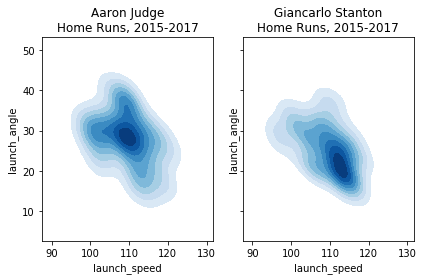
png
18.1.5 Home runs by pitch velocity
It appears that Stanton hits his home runs slightly lower and slightly harder than Judge, though this needs to be taken with a grain of salt given the small sample size of home runs.
Not only does Statcast measure the velocity of the ball coming off of the bat, it measures the velocity of the ball coming out of the pitcher’s hand and begins its journey towards the plate. We can use this data to compare Stanton and Judge’s home runs in terms of pitch velocity. Next you’ll find box plots displaying the five-number summaries for each player: minimum, first quartile, median, third quartile, and maximum.
# Combine the Judge and Stanton home run DataFrames for easy boxplot plotting
judge_stanton_hr = pd.concat([judge_hr,stanton_hr])# Create a boxplot that describes the pitch velocity of each player's home runs
sns.boxplot(judge_stanton_hr['release_speed'], color = 'tab:blue').set_title('Home Runs, 2015-2017')Text(0.5,1,‘Home Runs, 2015-2017’)
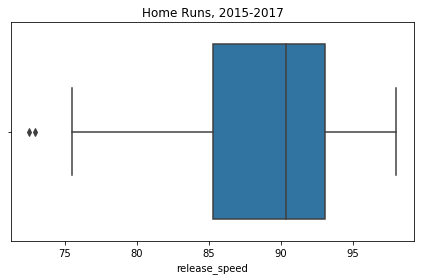
png
18.1.6 Home runs by pitch location (I)
So Judge appears to hit his home runs off of faster pitches than Stanton. We might call Judge a fastball hitter. Stanton appears agnostic to pitch speed and likely pitch movement since slower pitches (e.g. curveballs, sliders, and changeups) tend to have more break. Statcast does track pitch movement and type but let’s move on to something else: pitch location. Statcast tracks the zone the pitch is in when it crosses the plate. The zone numbering looks like this (from the catcher’s point of view):

We can plot this using a 2D histogram. For simplicity, let’s only look at strikes, which gives us a 9x9 grid. We can view each zone as coordinates on a 2D plot, the bottom left corner being (1,1) and the top right corner being (3,3). Let’s set up a function to assign x-coordinates to each pitch.
def assign_x_coord(row):
"""
Assigns an x-coordinate to Statcast's strike zone numbers. Zones 11, 12, 13,
and 14 are ignored for plotting simplicity.
"""
# Left third of strike zone
if row.zone in [1, 4, 7]:
return 1
# Middle third of strike zone
if row.zone in [2, 5, 8]:
return 2
# Right third of strike zone
if row.zone in [3, 6, 9]:
return 318.1.7 Home runs by pitch location (II)
And let’s do the same but for y-coordinates.
def assign_y_coord(row):
"""
Assigns a y-coordinate to Statcast's strike zone numbers. Zones 11, 12, 13,
and 14 are ignored for plotting simplicity.
"""
# Upper third of strike zone
if row.zone in [1,2,3]:
return 3
# Middle third of strike zone
if row.zone in [4,5,6]:
return 2
# Lower third of strike zone
if row.zone in [7,8,9]:
return 118.1.8 Aaron Judge’s home run zone
Now we can apply the functions we’ve created then construct our 2D histograms. First, for Aaron Judge (again, for pitches in the strike zone that resulted in home runs).
# Zones 11, 12, 13, and 14 are to be ignored for plotting simplicity
judge_strike_hr = judge_hr.copy().loc[judge_hr.zone <= 9]
# Assign Cartesian coordinates to pitches in the strike zone for Judge home runs
judge_strike_hr['zone_x'] = judge_strike_hr.apply(assign_x_coord, axis = 1)
judge_strike_hr['zone_y'] = judge_strike_hr.apply(assign_y_coord, axis = 1)
# Plot Judge's home run zone as a 2D histogram with a colorbar
plt.hist2d(judge_strike_hr['zone_x'], judge_strike_hr['zone_y'], bins = 3, cmap='Blues')
plt.title('Aaron Judge Home Runs on\n Pitches in the Strike Zone, 2015-2017')
plt.gca().get_xaxis().set_visible(False)
plt.gca().get_yaxis().set_visible(False)
cb = plt.colorbar()
cb.set_label('Counts in Bin')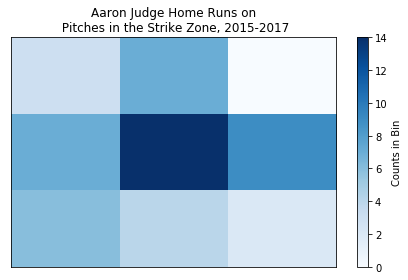
png
18.1.9 Giancarlo Stanton’s home run zone
And now for Giancarlo Stanton.
# Zones 11, 12, 13, and 14 are to be ignored for plotting simplicity
stanton_strike_hr = stanton_hr.copy().loc[stanton_hr.zone <= 9]
# Assign Cartesian coordinates to pitches in the strike zone for Stanton home runs
stanton_strike_hr['zone_x'] = stanton_strike_hr.apply(assign_x_coord, axis=1)
stanton_strike_hr['zone_y'] = stanton_strike_hr.apply(assign_y_coord, axis=1)
# Plot Stanton's home run zone as a 2D histogram with a colorbar
plt.hist2d(stanton_strike_hr['zone_x'], stanton_strike_hr['zone_y'], bins = 3, cmap='Blues')
plt.title('Giancarlo Stanton Home Runs on\n Pitches in the Strike Zone, 2015-2017')
plt.gca().get_xaxis().set_visible(False)
plt.gca().get_yaxis().set_visible(False)
cb = plt.colorbar()
cb.set_label('Counts in Bin')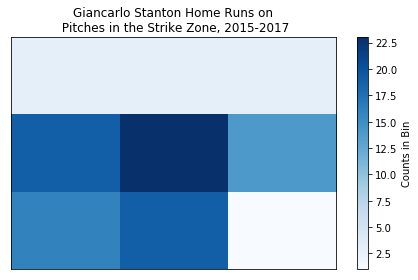
png
18.1.10 Should opposing pitchers be scared?
A few takeaways:
- Stanton does not hit many home runs on pitches in the upper third of the strike zone.
- Like pretty much every hitter ever, both players love pitches in the horizontal and vertical middle of the plate.
- Judge’s least favorite home run pitch appears to be high-away while Stanton’s appears to be low-away.
- If we were to describe Stanton’s home run zone, it’d be middle-inside. Judge’s home run zone is much more spread out.
The grand takeaway from this whole exercise: Aaron Judge and Giancarlo Stanton are not identical despite their superficial similarities. In terms of home runs, their launch profiles, as well as their pitch speed and location preferences, are different.
Should opposing pitchers still be scared?
参考文献
Datawhale. 2020. “50道练习实践学习Pandas!.” Datawhale. 2020. https://mp.weixin.qq.com/s/XmnWvnMNobuF-92vbppNbQ.
Friedman, Howard. 2020. “Which Debts Are Worth the Bank’s Effort?” DataCamp. 2020. https://www.datacamp.com/projects/504.
Leung, Deo. 2018. “How Floor a Date to the First Date of That Month?” Stack Overflow. 2018. https://stackoverflow.com/a/49869631/8625228.
Orac, Roman. 2020. “不容错过的Pandas小技巧:万能转格式、轻松合并、压缩数据,让数据分析更高效.” 量子位. 2020. https://mp.weixin.qq.com/s/RY9efkvdPE5JJq6UWWOFFw.
Reback, Jeff. 2017. “Can’t Use Dt.ceil, Dt.floor, Dt.round with Coarser Target Frequencies.” GitHub. 2017. https://github.com/pandas-dev/pandas/issues/15303#issuecomment-277401817.
Venturi, David. 2020. “A New Era of Data Analysis in Baseball.” DataCamp. 2020. https://www.datacamp.com/projects/250.
易执. 2020. “Pandas数据分析——超好用的Groupby详解.” Python读数. 2020. https://mp.weixin.qq.com/s/9OoNH8MMpYlZhABGjGvvzQ.